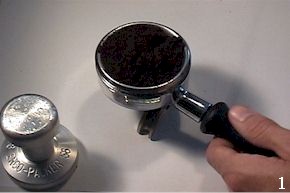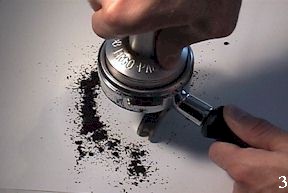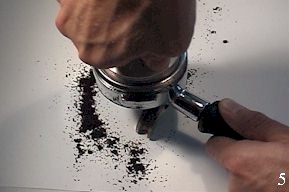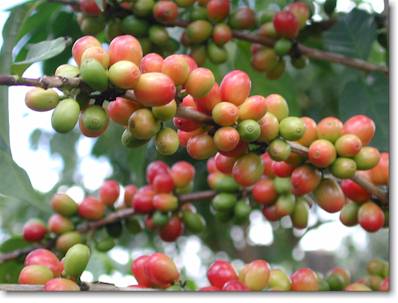Espresso Tamping
 Espresso Tamping is an art that is often neglected in espresso preparation. The goal is to create a pellet of coffee through which the hot water from the espresso machine will penetrate evenly. Since the water from the espresso machine is under pressure, the espresso pellet must be hard and evenly tamped. The water only knows how to go from a region of high pressure to a region of low pressure. Therefore it is important to prevent paths of least resistance in the coffee pellet and force the water to evenly permeate and extract the coffee.
Espresso Tamping is an art that is often neglected in espresso preparation. The goal is to create a pellet of coffee through which the hot water from the espresso machine will penetrate evenly. Since the water from the espresso machine is under pressure, the espresso pellet must be hard and evenly tamped. The water only knows how to go from a region of high pressure to a region of low pressure. Therefore it is important to prevent paths of least resistance in the coffee pellet and force the water to evenly permeate and extract the coffee.
This chapter assumes that one has read and understood how to dose the coffee properly. After the ground coffee has been dosed into the porta-filter it is unevenly distributed. Hold the porta-filter in one hand while using the other hand to quickly, but gently level the coffee. This is usually accomplished by pulling the coffee to one side of the basket with a slightly curled pinky, then pushing the coffee back to the opposite side of the basket (Picture 2). The key is to evenly distribute the coffee without pressing into the grounds or leaving any empty space on the sides of the basket.
 Correct Espresso Tamping
Correct Espresso Tamping
Once you are done distributing the grounds, it is time for the first tamp. Without moving the porta-filter, hold the espresso tamper so that the base of the handle fits into the palm of your hand. Your wrist should be straight, and the espresso tamper should be a straight extension of your arm. Press gently on the coffee with five pounds of pressure (Picture 3). You will notice that some of the grounds will stick to the side of the basket. Therefore, one must gently tap the basket with the handle on the porta-filter to knock the grounds onto the flat pellet you just formed (Picture 4).
The next step is to apply the finishing espresso tamp (Picture 5). The shape of the pellet has already been formed, and the finishing tamp confirms this impression. With the tamping tool held as before, press on the pellet with thirty pounds of pressure. It is useful to tamp espresso on a bathroom scale until you become comfortable with the amount of force necessary to achieve the appropriate pressure. After tamping, turn the espresso tamper 720° while continuing to apply pressure to polish the surface. Make sure you tamp evenly. An uneven espresso tamp will result in an uneven extraction.
 The above steps should be carried out in about thirty seconds. Although speed is important, it is necessary to be careful not to bump the basket during this process. Sharply hitting the basket will unevenly distribute the grounds allowing shortcuts for the water to pass through. As any scientist can appreciate, the path of least resistance is preferred. If there are any weak spots or holes in the espresso pellet the water will push through this area, over extracting this portion of coffee while under extracting the rest of the pellet. Improper espresso tamping will result in a twirling pour or white crema.
The above steps should be carried out in about thirty seconds. Although speed is important, it is necessary to be careful not to bump the basket during this process. Sharply hitting the basket will unevenly distribute the grounds allowing shortcuts for the water to pass through. As any scientist can appreciate, the path of least resistance is preferred. If there are any weak spots or holes in the espresso pellet the water will push through this area, over extracting this portion of coffee while under extracting the rest of the pellet. Improper espresso tamping will result in a twirling pour or white crema.
 Check the spacing above the espresso pellet and below the dispersion screen. You can do this by dosing, distributing, and tamping as described above. Then insert the porta-filter and remove it. Does the screen or screw press down onto the coffee? If so, the coffee will not have enough room to expand as it is brewing. On the other hand you want to have between 16-18 grams of coffee in the basket. Experiment with these two factors until you achieve a good height for the espresso pellet.
Check the spacing above the espresso pellet and below the dispersion screen. You can do this by dosing, distributing, and tamping as described above. Then insert the porta-filter and remove it. Does the screen or screw press down onto the coffee? If so, the coffee will not have enough room to expand as it is brewing. On the other hand you want to have between 16-18 grams of coffee in the basket. Experiment with these two factors until you achieve a good height for the espresso pellet.
Choosing the Correct Espresso Tamper
Just as correct espresso tamping is essential, so is the use of a proper espresso tamper. The first action you should take is to throw away the plastic round bottom tamper that you currently have. The espresso tamper should be made of aluminum or similar light metal and should have a diameter so it fits firmly into the basket. Marzocco baskets are 58mm, so order the appropriate size. Without a flat packing surface, you create indents which cause uneven extraction. You may order your espresso tamper from Vivace's which sells several different size pistons to perfectly fit your basket. Currently, Vivace's has recommended the use of a round bottom coffee tamper rather than the traditional flat bottom tamping machines. This suggestion is welcome to further discussion. Currently, my observations do not support the conclusion that the rounded bottom tamper is better. Initial crema is thicker, but overall crema is less. I will continue tests with other espresso machines and with other espresso blends. You should also order the book "Espresso Coffee: Professional Techniques," a great book on espresso preparation.

 The caffeine in coffee occurs naturally; it’s not added to coffee (as it is, for example, added to many soft drinks.) Coffee – with its stimulating constituent, caffeine – is the most popular mood-altering substance on the planet, and has been for more than 300 years.
The caffeine in coffee occurs naturally; it’s not added to coffee (as it is, for example, added to many soft drinks.) Coffee – with its stimulating constituent, caffeine – is the most popular mood-altering substance on the planet, and has been for more than 300 years. Nutritionally speaking, brewed coffee is pretty much inert.
Nutritionally speaking, brewed coffee is pretty much inert.  Provided that what ails you is a lack of alertness or a sour mood, it’s good on its promise. Let’s leave patent medicines aside for the moment, though, and ask:
Provided that what ails you is a lack of alertness or a sour mood, it’s good on its promise. Let’s leave patent medicines aside for the moment, though, and ask: 


 We then grind and brew these coffees in open bowls, and judge their merits on the following qualities:
We then grind and brew these coffees in open bowls, and judge their merits on the following qualities:  It involves matching roast temperature and time with a given bean to maximize its potential. When you start with beans of great character, it's crucial that you roast them appropriately, so as not to obscure the coffee's origin flavors and aromas.
It involves matching roast temperature and time with a given bean to maximize its potential. When you start with beans of great character, it's crucial that you roast them appropriately, so as not to obscure the coffee's origin flavors and aromas.  from choosing the the best coffee varietals to plant and grow, to ensuring the health of the coffee trees and the overall ecosystem. We may find a cooperative would benefit from a new coffee drying patio, or better source of fresh water or power. Often we can help finance these improvements.
from choosing the the best coffee varietals to plant and grow, to ensuring the health of the coffee trees and the overall ecosystem. We may find a cooperative would benefit from a new coffee drying patio, or better source of fresh water or power. Often we can help finance these improvements.  But it's often the only choice of rural inhabitants in developing countries to provide for their families.
But it's often the only choice of rural inhabitants in developing countries to provide for their families.  dream of dry-processing his hard, dense and fruity beans… he’d probably sooner leave them on the tree (which, in countries like Yemen is a not an altogether unusual practice).
dream of dry-processing his hard, dense and fruity beans… he’d probably sooner leave them on the tree (which, in countries like Yemen is a not an altogether unusual practice).  It can be argued that these regions have an ample natural resource… the sun! As it happens, there are regions within Ethiopia that that dry-process and sun-dry their coffees, to wonderful effect… it’s just this process that gives us the celebrated Ethiopian Harrar coffee.
It can be argued that these regions have an ample natural resource… the sun! As it happens, there are regions within Ethiopia that that dry-process and sun-dry their coffees, to wonderful effect… it’s just this process that gives us the celebrated Ethiopian Harrar coffee.  Soil must drain well, be slightly acidic and rich with minerals. Weeds and creepers must be kept in check, but not eliminated; they cling to precious soil that might otherwise wash down the mountain slopes. Finally, coffee trees must be shaded from harsh sun, so a canopy of banana, nut and other fruit and hardwoods is planted and tended, too.
Soil must drain well, be slightly acidic and rich with minerals. Weeds and creepers must be kept in check, but not eliminated; they cling to precious soil that might otherwise wash down the mountain slopes. Finally, coffee trees must be shaded from harsh sun, so a canopy of banana, nut and other fruit and hardwoods is planted and tended, too.  and picking is done exclusively by hand, as only the ripest cherries will do. Fruit that’s too ripe will be sorted out in later processing, but under-ripe fruit is left on the tree for later pickings. Each tree will be visited as many as four times over the precious few days that ripeness is at is peak.
and picking is done exclusively by hand, as only the ripest cherries will do. Fruit that’s too ripe will be sorted out in later processing, but under-ripe fruit is left on the tree for later pickings. Each tree will be visited as many as four times over the precious few days that ripeness is at is peak. 
 Early coffeehouses served more than coffee; they also served as hotbeds of conversation, politics and commerce. One coffeehouse might serve as a gathering place for physicians, another for actors, or musicians, or lawyers or clergy. These gathering places became known as Penny Universities… for the price of a cup of coffee, one could sit for hours and participate in the discourse of the day.
Early coffeehouses served more than coffee; they also served as hotbeds of conversation, politics and commerce. One coffeehouse might serve as a gathering place for physicians, another for actors, or musicians, or lawyers or clergy. These gathering places became known as Penny Universities… for the price of a cup of coffee, one could sit for hours and participate in the discourse of the day.  to never allow beans or cuttings that could create new coffee plants to leave Arabian borders... coffee had become so precious to them, it was made illegal to export fertile beans.
to never allow beans or cuttings that could create new coffee plants to leave Arabian borders... coffee had become so precious to them, it was made illegal to export fertile beans.  about eating strange foods from strange places — Kaldi sampled the berries, himself. In no time, he too was dancing gleefully with his goats around the green-leafed shrubs.
about eating strange foods from strange places — Kaldi sampled the berries, himself. In no time, he too was dancing gleefully with his goats around the green-leafed shrubs.  We begin our day with a breakfast cup. Share stories and secrets and laughter over a late afternoon latte. We end a perfect meal with dessert and a dark-roasted demitasse.
We begin our day with a breakfast cup. Share stories and secrets and laughter over a late afternoon latte. We end a perfect meal with dessert and a dark-roasted demitasse. 
 According to a coffee history legend, an Arabian shepherd named Kaldi found his goats dancing joyously around a dark green leafed shrub with bright red cherries in the southern tip of the Arabian Peninsula. Kaldi soon determined that it was the bright red cherries on the shrub that were causing the peculiar euphoria and after trying the cherries himself, he learned of their powerful effect. The stimulating effect was then exploited by monks at a local monastery to stay awake during extended hours of prayer and distributed to other monasteries around the world. Coffee was born.
According to a coffee history legend, an Arabian shepherd named Kaldi found his goats dancing joyously around a dark green leafed shrub with bright red cherries in the southern tip of the Arabian Peninsula. Kaldi soon determined that it was the bright red cherries on the shrub that were causing the peculiar euphoria and after trying the cherries himself, he learned of their powerful effect. The stimulating effect was then exploited by monks at a local monastery to stay awake during extended hours of prayer and distributed to other monasteries around the world. Coffee was born. Espresso Tamping is an art that is often neglected in espresso preparation. The goal is to create a pellet of coffee through which the hot water from the espresso machine will penetrate evenly. Since the water from the espresso machine is under pressure, the espresso pellet must be hard and evenly tamped. The water only knows how to go from a region of high pressure to a region of low pressure. Therefore it is important to prevent paths of least resistance in the coffee pellet and force the water to evenly permeate and extract the coffee.
Espresso Tamping is an art that is often neglected in espresso preparation. The goal is to create a pellet of coffee through which the hot water from the espresso machine will penetrate evenly. Since the water from the espresso machine is under pressure, the espresso pellet must be hard and evenly tamped. The water only knows how to go from a region of high pressure to a region of low pressure. Therefore it is important to prevent paths of least resistance in the coffee pellet and force the water to evenly permeate and extract the coffee.
 The above steps should be carried out in about thirty seconds. Although speed is important, it is necessary to be careful not to bump the basket during this process. Sharply hitting the basket will unevenly distribute the grounds allowing shortcuts for the water to pass through. As any scientist can appreciate, the path of least resistance is preferred. If there are any weak spots or holes in the espresso pellet the water will push through this area, over extracting this portion of coffee while under extracting the rest of the pellet. Improper espresso tamping will result in a twirling pour or white crema.
The above steps should be carried out in about thirty seconds. Although speed is important, it is necessary to be careful not to bump the basket during this process. Sharply hitting the basket will unevenly distribute the grounds allowing shortcuts for the water to pass through. As any scientist can appreciate, the path of least resistance is preferred. If there are any weak spots or holes in the espresso pellet the water will push through this area, over extracting this portion of coffee while under extracting the rest of the pellet. Improper espresso tamping will result in a twirling pour or white crema. Check the spacing above the espresso pellet and below the dispersion screen. You can do this by dosing, distributing, and tamping as described above. Then insert the porta-filter and remove it. Does the screen or screw press down onto the coffee? If so, the coffee will not have enough room to expand as it is brewing. On the other hand you want to have between 16-18 grams of coffee in the basket. Experiment with these two factors until you achieve a good height for the espresso pellet.
Check the spacing above the espresso pellet and below the dispersion screen. You can do this by dosing, distributing, and tamping as described above. Then insert the porta-filter and remove it. Does the screen or screw press down onto the coffee? If so, the coffee will not have enough room to expand as it is brewing. On the other hand you want to have between 16-18 grams of coffee in the basket. Experiment with these two factors until you achieve a good height for the espresso pellet.





